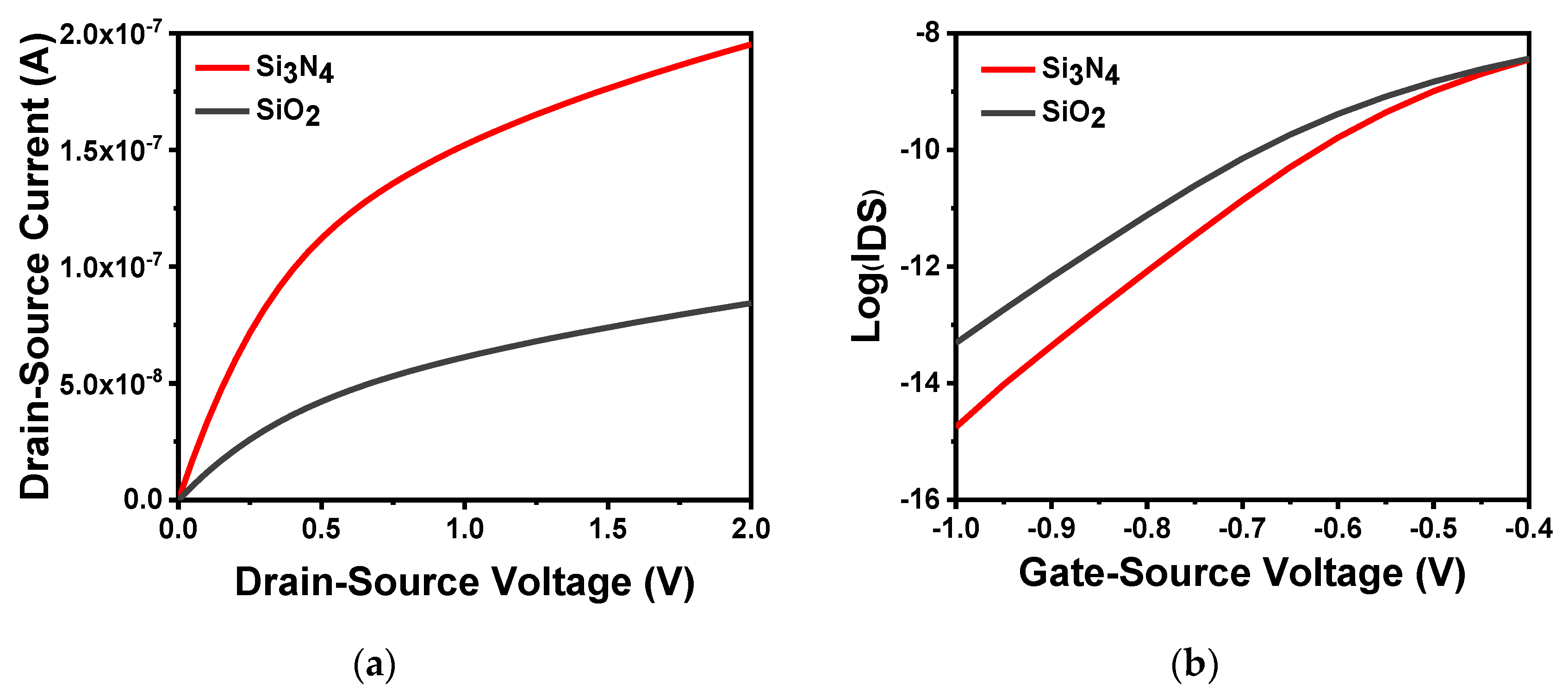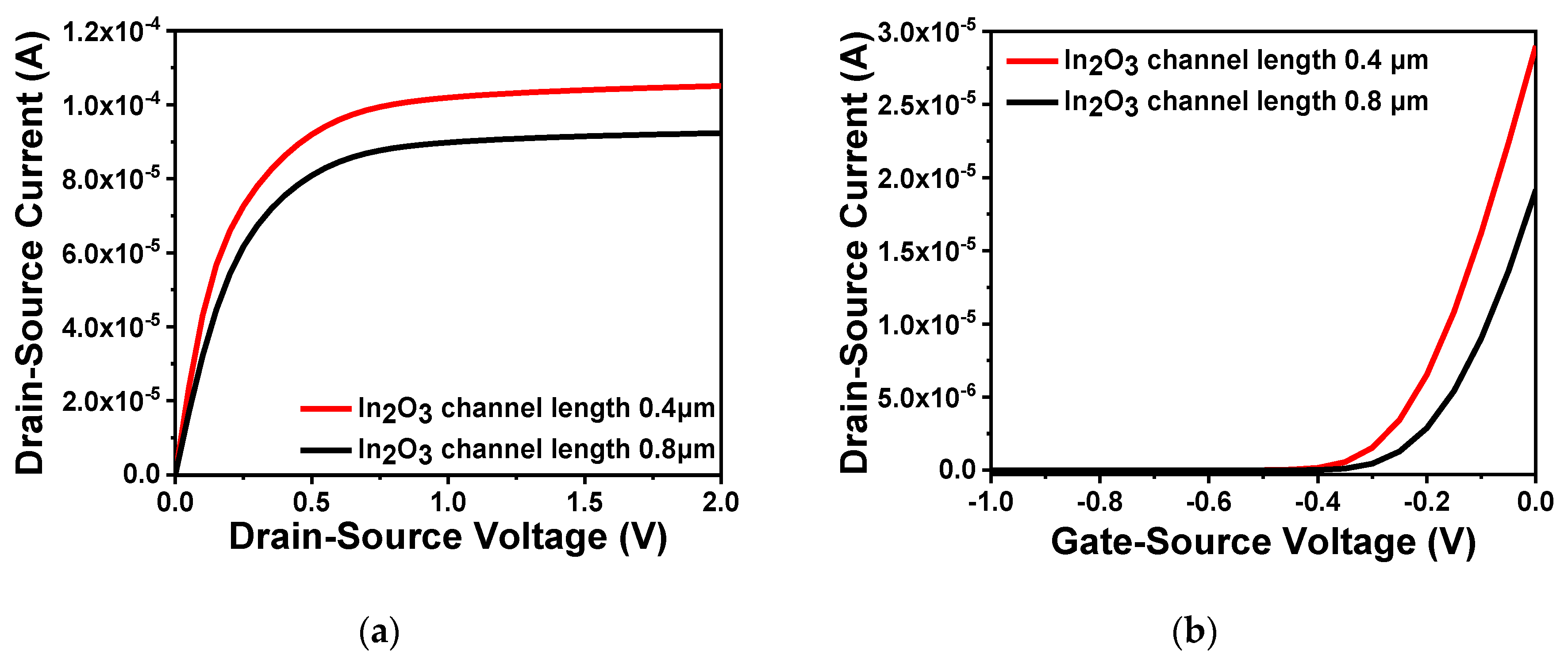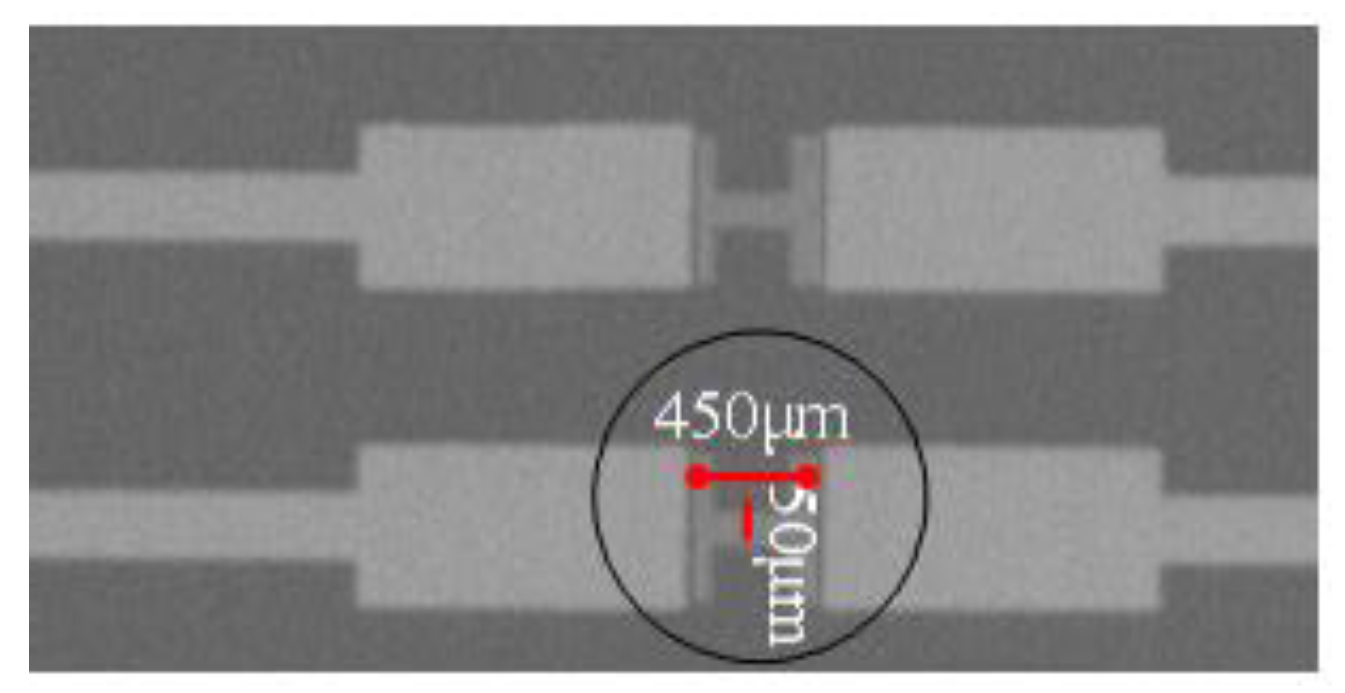Design and Implementation of a pH Sensor for Micro Solution Based on Nanostructured Ion-Sensitive Field-Effect Transistor
Abstract
1. Introduction
2. Structure of Device and Simulation
3. Theoretical Analysis
3.1. Threshold Voltage
3.2. Source–Drain Current
3.3. Subthreshold Swing
4. Results and Discussion
4.1. Description of Electrical Characteristics of Devices
4.2. Material Performance Analysis
4.2.1. Material Analysis of a Gate Dielectric Layer
4.2.2. Analysis of Semiconductor Material
4.3. Influence of Channel Parameters on Device Performance
4.4. Device Performance Verification
5. Conclusions
Author Contributions
Funding
Conflicts of Interest
References
- Bergveld, P. Development of an ion-sensitive solid-state device for neurophysiological measurements. IEEE Trans. Bio-Med. Eng. 1970, 17, 70–71. [Google Scholar] [CrossRef]
- Akbari, E.; Moradi, R.; Afroozeh, A.; Alizadeh, A.; Nilashi, M. A new approach for prediction of graphene based ISFET using regression tree and neural network. Superlattices Microstruct. 2019, 241–248. [Google Scholar] [CrossRef]
- Bresnahan, P.J., Jr.; Martz, T.R.; Takeshita, Y.; Johnson, K.S.; LaShomb, M. Best practices for autonomous measurements of seawater pH with the Honeywell Durafet. Methods Oceanogr. 2014, 9, 44–60. [Google Scholar] [CrossRef]
- Gonski, S.F.; Cai, W.; Ullman, W.J.; Joesoef, A.; Main, C.R.; Pettay, D.T.; Martz, T.R. Assessment of the suitability of Durafet-based sensors for pH measurement in dynamic estuarine environments. Estuar. Coast. Shelf Sci. 2018, 152–168. [Google Scholar] [CrossRef]
- Briggs, E.M.; Sandoval, S.; Erten, A.; Takeshita, Y.; Kummel, A.C.; Martz, T.R. Solid State Sensor for Simultaneous Measurement of Total Alkalinity and pH of Seawater. ACS Sens. 2017, 2. [Google Scholar] [CrossRef]
- Johnson, K.S.; Jannasch, H.W.; Coletti, L.J.; Elrod, V.A.; Martz, T.R.; Takeshita, Y.; Carlson, R.J.; Connery, J.G. Deep-Sea DuraFET. A Pressure Tolerant pH Sensor Designed for Global Sensor Networks. Anal. Chem. 2016, 88, 3249–3256. [Google Scholar] [CrossRef]
- Bong, J.H.; Kim, H.R.; Yoo, J.W.; Kang, M.J.; Shin, M.G.; Lee, J.S.; Pyun, J.C. One-step immunoassay without washing steps for influenza A virus detection using ISFET. Biosens. Bioelectron. 2020, 112341. [Google Scholar] [CrossRef]
- McLaughlin, K.; Dickson, A.; Weisberg, S.B.; Coale, K.; Elrod, V.; Hunter, C.; Johnson, K.S.; Kram, S.; Kudela, R.; Martz, T.; et al. An evaluation of ISFET sensors for coastal pH monitoring applications. Reg. Stud. Mar. Sci. 2017, 12, 11–18. [Google Scholar] [CrossRef]
- Zhao, S.; Shi, C.; Hu, H.; Li, Z.; Xiao, G.; Yang, Q.; Yue, Z. ISFET and Dex-AgNPs based portable sensor for reusable and real-time determinations of concanavalin A and glucose on smartphone. Biosens. Bioelectron. 2020, 151, 111962. [Google Scholar] [CrossRef]
- Sasipongpana, S.; Rayanasukha, Y.; Prichanont, S.; Thanachayanont, C.; Porntheeraphat, S.; Houngkamhang, N. Extended–gate field effect transistor (EGFET) for carbaryl pesticide detection based on enzyme inhibition assay. Mater. Today Proc. 2017, 4, 6458–6465. [Google Scholar] [CrossRef]
- Joly, M.; Mazenq, L.; Marlet, M.; Temple-Boyer, P.; Durieu, C.; Launay, J. Multimodal probe based on ISFET electrochemical microsensors for in-situ monitoring of soil nutrients in agriculture. Multidiscip. Digit. Publ. Inst. Proc. 2017, 1, 420. [Google Scholar] [CrossRef]
- Cho, S.K.; Cho, W.J. Ultra-high sensitivity pH-sensors using silicon nanowire channel dual-gate field-effect transistors fabricated by electrospun polyvinylpyrrolidone nanofibers pattern template transfer. Sens. Actuators B Chem. 2021, 326, 128835. [Google Scholar] [CrossRef]
- Lee, I.K.; Lee, K.H.; Lee, S.; Cho, W.J. Microwave annealing effect for highly reliable biosensor: Dual-gate ion-sensitive field-effect transistor using amorphous InGaZnO thin-film transistor. ACS Appl. Mater. Interfaces 2014, 6, 22680–22686. [Google Scholar] [CrossRef]
- Duarte, G.C.; Lai, F.L.; Cheng, C.W.; Reddy, B.J.; Salm, E.; Swaminathan, V.; Tsui, Y.K.; Tuan, H.C.; Kalnitsky, A.; Liu, Y.S.; et al. Enhanced biosensing resolution with foundry fabricated individually addressable dual-gated ISFETs. Anal. Chem. 2014, 86, 8359–8367. [Google Scholar] [CrossRef]
- Zhou, K.; Zhao, Z.; Yu, P.; Wang, Z. Highly sensitive pH sensors based on double-gate silicon nanowire field-effect transistors with dual-mode amplification. Sens. Actuators B Chem. 2020, 320, 128403. [Google Scholar] [CrossRef]
- Knopfmacher, O.; Tarasov, A.; Fu, W.; Wipf, M.; Niesen, B.; Calame, M.; Schönenberger, C. Nernst limit in dual-gated Si-nanowire FET sensors. Nano Lett. 2010, 10, 2268–2274. [Google Scholar] [CrossRef]
- Alam, A.U.; Qin, C.; Nambiar, S.; Yeow, J.T.; Howlader, M.M.; Hu, N.; Deen, M.J. Polymers and organic materials-based pH sensors for healthcare applications. Prog. Mater. Sci. 2018, 96, 174–216. [Google Scholar] [CrossRef]
- Ibau, C.; Md Arshad, M.K.; Gopinath, S.C.B. Current advances and future visions on bioelectronics immunosensing for prostate-specific antigen. Biosens. Bioelectron. 2017, 98, 267–284. [Google Scholar] [CrossRef]
- Kaisti, M. Detection principles of biological and chemical FET sensors. Biosens. Bioelectron. 2017, 98, 437–448. [Google Scholar] [CrossRef]
- Bhattacharyya, I.M.; Cohen, S.; Shalabny, A.; Bashouti, M.; Akavayov, B.; Shalev, B. Specific and label-free immunosensing of protein-protein interactions with silicon-based immunoFETs. Biosens. Bioelectron. 2019, 132, 143–161. [Google Scholar] [CrossRef]
- Jeun, M.; Park, S.; Kim, Y.; Choi, J.; Song, S.H.; Jeong, I.G.; Soo, C. Self-Normalized Detection of ANXA3 from Untreated Urine of Prostate Cancer Patients without Digital Rectal Examination. Adv. Healthc. Mater. 2017, 6, 1700449. [Google Scholar] [CrossRef] [PubMed]
- Sharma, P.K.; Thakur, H.R.; Dutta, J.C. Modeling and simulation of carbon nanotube-based dual-gated enzyme field effect transistor for acetylcholine detection. J. Comput. Electron. 2017, 16, 584–592. [Google Scholar] [CrossRef]
- Kwon, D.W.; Lee, R.; Kim, S.; Mo, H.; Kim, D.H.; Park, B. A novel fabrication method for co-integrating ISFET with damage-free sensing oxide and threshold voltage-tunable CMOS read-out circuits. Sens. Actuators B Chem. 2017, 260, 627–634. [Google Scholar] [CrossRef]
- Zhu, X.; Li, Y.; Zhang, H.; Song, L.; Zu, H.; Qin, Y.B.; Wang, F. High-performance field effect transistors based on large ratio metal (Al, Ga, Cr) doped In2O3 nanofibers. J. Alloys Compd. 2020, 830, 154578. [Google Scholar] [CrossRef]
- Manjakkal, L.; Szwagierczak, D.; Dahiya, R. Metal oxides based electrochemical pH sensors: Current progress and future perspectives. Prog. Mater. Sci. 2020, 109, 100635. [Google Scholar] [CrossRef]
- Shetti, N.P.; Bukkitgar, S.D.; Reddy, K.R.; Reddy, C.V.; Aminabhavi, T.M. Nanostructured titanium oxide hybrids-based electrochemical biosensors for healthcare applications. Colloids Surf. B Biointerfaces 2019, 178, 385–394. [Google Scholar] [CrossRef]
- Kutova, O.; Dusheiko, M.; Klyui, N.I.; Skryshevsky, V.A. C-reactive protein detection based on ISFET structure with gate dielectric SiO2-CeO2. Microelectron. Eng. 2019, 215, 110993. [Google Scholar] [CrossRef]
- Salvo, P.; Melai, B.; Calisi, N.; Paoletti, C.; Bellagambi, F.G.; Kirchhain, A.; Francesco, F.D. Graphene-based devices for measuring pH. Sens. Actuators B Chem. 2018, 256, 976–991. [Google Scholar] [CrossRef]
- Wu, Y.C.; Wu, S.J.; Lin, C.H. Mass-produced polyethylene-terephthalate film coated with tantalum pentoxide for pH measurement under ISFET detection configuration. Microsyst. Technol. 2017, 23, 293–298. [Google Scholar] [CrossRef]
- Andrianova, M.S.; Kuznetsov, E.V.; Grudtsov, V.P.; Kuznetsov, A.E. CMOS-compatible biosensor for L-carnitine detection. Biosens. Bioelectron. 2018, 119, 48–54. [Google Scholar] [CrossRef]
- Li, L.; Li, X.; Pu, T.; Liu, Y.; Ao, J.P. Normally off AlGaN/GaN ion-sensitive field effect transistors realized by photoelectrochemical method for pH sensor application. Superlattices Microstruct. 2019, 128, 99–104. [Google Scholar] [CrossRef]
- Rishabh, B.; Soumendu, S.; Nishad, S.; Sagnik, M.; Pratik, N.; Ravindra, M. Modeling and simulation of temperature drift for ISFET-based pH sensor and its compensation through machine learning techniques. Int. J. Circ. Appl. 2019, 47, 954–970. [Google Scholar] [CrossRef]
- Dinar, A.M.; Zain, A.M.; Salehuddin, F.; Attiah, M.L.; Abdulhameed, M.K. Modeling and simulation of electrolyte pH change in conventional ISFET using commercial Silvaco TCAD. IOP Conf. Mater. Sci. Eng. 2019, 518. [Google Scholar] [CrossRef]
- Qazi, S.; Raza, K. Smart biosensors for an efficient point of care (PoC) health management. In Smart Biosensors in Medical Care; Jyotismita, C., Nilanjan, D., Debashis, D., Eds.; Elsevier: Amsterdam, The Netherlands, 2020; pp. 65–85. [Google Scholar] [CrossRef]
- Su, F.; Zhang, Z.; Li, S.; Li, P.; Deng, T. Long-term stability of photodetectors based on graphene field-effect transistors encapsulated with Si3N4 layers. Appl. Surf. Sci. 2018, 459, 164–170. [Google Scholar] [CrossRef]
- Chaudhary, R.; Mukhiya, R.; Patel, G.S.; Mudimela, P.R.; Sharma, R. Simulation of MOSFET with Different Dielectric Films. In Proceedings of the 2018 International Conference on Intelligent Circuits and Systems (ICICS), Phagwara, India, 19–20 April 2018. [Google Scholar] [CrossRef]
- Marc, J.M.; Morrison, S.R. Silicon-Based Chemical Sensors. In Chemical Sensing with Solid State Devices; Marc, J.M., Morrison, S.R., Eds.; Academic Press: Cambridge, MA, USA, 1989; pp. 359–417. [Google Scholar] [CrossRef]
- Anastasescu, C.; Zaharescu, M.; Angelescu, D.; Munteanu, C.; Bratan, V.; Spataru, T.; Negrila, C.; Spataru, N.; Balint, I. Defect-related light absorption, photoluminiscence and photocatalytic activity of SiO2 with tubular morphology. Sol. Energy Mater. Sol. Cells 2017, 159, 325–335. [Google Scholar] [CrossRef]
- Kulikov, N.A.; Popov, V.D. Effect of the Electric Mode and γ Irradiation on Surface-Defect Formation at the Si–SiO2 Interface in a MOS Transistor. Semiconductors 2019, 53, 110–113. [Google Scholar] [CrossRef]
- Niu, M.; Ding, X.; Tong, Q. Effect of two types of surface sites on the characteristics of Si3N4-gate pH-ISFETs. Sens. Actuators B Chem. 1996, 37, 13–17. [Google Scholar] [CrossRef]
- Razavi, S.M.; Pour, S.T.; Najari, P. New GaN based HEMT with Si3N4 or un-doped region in the barrier for high power applications. Superlattices Microstruct. 2018, 118, 221–229. [Google Scholar] [CrossRef]
- Koike, K.; Mori, Y.; Sasa, S.; Hirofuji, Y.; Yano, M. Glucose Sensing by an Enzyme-modified ZnO-based FET. Procedia Eng. 2016, 84–88. [Google Scholar] [CrossRef]
- Lee, D.; Cui, T. A role of silica nanoparticles in layer-by-layer self-assembled carbon nanotube and In2O3 nanoparticle thin-film pH sensors: Tunable sensitivity and linearity. Sens. Actuators A Phys. 2012, 188, 203–211. [Google Scholar] [CrossRef]
- Kim, J.; Lee, W.; Choi, S.; Kim, K.; Heo, J.S.; Park, S.K.; Kim, Y. Dual-gate crystalline oxide-nanowire field-effect transistors utilizing ion-gel gate dielectric. Appl. Surf. Sci. 2020, 515, 145988. [Google Scholar] [CrossRef]
- Liu, Y.; Zhu, S.; Wei, R.; Hu, L.; Tang, X.; Yang, J.; Song, W.; Dai, J.; Zhu, X.; Sun, Y. Solution processed W-doped In2O3 thin films with high carrier mobility. Ceram. Int. 2020, 46, 2173–2177. [Google Scholar] [CrossRef]
- Zeumault, A.; Scheideler, W.; Subramanian, V. Subramanian. Electrostatic Tuning of Spray-Deposited ZnO for Controlled Mobility Enhancement. Adv. Funct. Mater. 2017, 27, 1701021. [Google Scholar] [CrossRef]
- Liu, Q.H.; Wei, Y.L.; Cao, Y.X.; Zhao, C.; Zhao, C.Z.; Mitrovic, I.Z.; Hall, S.; Xu, W.Y.; Yang, L.; Lim, E.G.; et al. Fully Solution-Processed Sodium Doped ZnO Thin-Film Transistors via a Low-Temperature Aqueous Route. In Proceedings of the 2019 Joint International EUROSOI Workshop and International Conference on Ultimate Integration on Silicon (EUROSOI-ULIS), Grenoble, France, 1–3 April 2019. [Google Scholar] [CrossRef]













| Parameters | In2O3 | Si3N4 | Si | Gate |
|---|---|---|---|---|
| permittivity | 3.7 | 7.5 | 11.8 | 11.8 |
| thickness | 50 nm | 50 nm | 600 nm | 30 nm |
| length | 400 nm | 1.2 μm | 1.2 μm | 1.2 μm |
| Thickness (μm) | 0.02 | 0.05 | 0.1 | 0.12 | 0.15 |
|---|---|---|---|---|---|
| Subthreshold slope (mV/dec) | 67.66 | 81.38 | 170.14 | 273.25 | 535.03 |
Publisher’s Note: MDPI stays neutral with regard to jurisdictional claims in published maps and institutional affiliations. |
© 2020 by the authors. Licensee MDPI, Basel, Switzerland. This article is an open access article distributed under the terms and conditions of the Creative Commons Attribution (CC BY) license (http://creativecommons.org/licenses/by/4.0/).
Share and Cite
Wang, Y.; Yang, M.; Wu, C. Design and Implementation of a pH Sensor for Micro Solution Based on Nanostructured Ion-Sensitive Field-Effect Transistor. Sensors 2020, 20, 6921. https://doi.org/10.3390/s20236921
Wang Y, Yang M, Wu C. Design and Implementation of a pH Sensor for Micro Solution Based on Nanostructured Ion-Sensitive Field-Effect Transistor. Sensors. 2020; 20(23):6921. https://doi.org/10.3390/s20236921
Chicago/Turabian StyleWang, Yiqing, Min Yang, and Chuanjian Wu. 2020. "Design and Implementation of a pH Sensor for Micro Solution Based on Nanostructured Ion-Sensitive Field-Effect Transistor" Sensors 20, no. 23: 6921. https://doi.org/10.3390/s20236921
APA StyleWang, Y., Yang, M., & Wu, C. (2020). Design and Implementation of a pH Sensor for Micro Solution Based on Nanostructured Ion-Sensitive Field-Effect Transistor. Sensors, 20(23), 6921. https://doi.org/10.3390/s20236921






